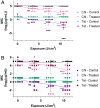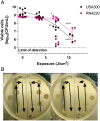Breaking down antibiotic resistance in methicillin-resistant Staphylococcus aureus: Combining antimicrobial photodynamic and antibiotic treatments
- PMID: 36037346
- PMCID: PMC9457041
- DOI: 10.1073/pnas.2208378119
Breaking down antibiotic resistance in methicillin-resistant Staphylococcus aureus: Combining antimicrobial photodynamic and antibiotic treatments
Abstract
The widespread use of antibiotics drives the evolution of antimicrobial-resistant bacteria (ARB), threatening patients and healthcare professionals. Therefore, the development of novel strategies to combat resistance is recognized as a global healthcare priority. The two methods to combat ARB are development of new antibiotics or reduction in existing resistances. Development of novel antibiotics is a laborious and slow-progressing task that is no longer a safe reserve against looming risks. In this research, we suggest a method for reducing resistance to extend the efficacious lifetime of current antibiotics. Antimicrobial photodynamic therapy (aPDT) is used to generate reactive oxygen species (ROS) via the photoactivation of a photosensitizer. ROS then nonspecifically damage cellular components, leading to general impairment and cell death. Here, we test the hypothesis that concurrent treatment of bacteria with antibiotics and aPDT achieves an additive effect in the elimination of ARB. Performing aPDT with the photosensitizer methylene blue in combination with antibiotics chloramphenicol and tetracycline results in significant reductions in resistance for two methicillin-resistant Staphylococcus aureus (MRSA) strains, USA300 and RN4220. Additional resistant S. aureus strain and antibiotic combinations reveal similar results. Taken together, these results suggest that concurrent aPDT consistently decreases S. aureus resistance by improving susceptibility to antibiotic treatment. In turn, this development exhibits an alternative to overcome some of the growing MRSA challenge.
Keywords: antibiotic resistance; antimicrobial-resistant bacteria; methicillin-resistant Staphylococcus aureus; methylene blue; photodynamic therapy.
Conflict of interest statement
The authors declare no competing interest.
Figures






Similar articles
-
Targeted Antimicrobial Photodynamic Therapy of Biofilm-Embedded and Intracellular Staphylococci with a Phage Endolysin's Cell Binding Domain.Microbiol Spectr. 2022 Feb 23;10(1):e0146621. doi: 10.1128/spectrum.01466-21. Epub 2022 Feb 23. Microbiol Spectr. 2022. PMID: 35196798 Free PMC article.
-
Effects of antimicrobial photodynamic therapy with photodithazine® on methicillin-resistant Staphylococcus aureus (MRSA): Studies in biofilms and experimental model with Galleria mellonella.J Photochem Photobiol B. 2024 Mar;252:112860. doi: 10.1016/j.jphotobiol.2024.112860. Epub 2024 Feb 3. J Photochem Photobiol B. 2024. PMID: 38330692
-
Photodynamic activation of phytochemical-antibiotic combinations for combatting Staphylococcus aureus from acute wound infections.J Photochem Photobiol B. 2024 Sep;258:112978. doi: 10.1016/j.jphotobiol.2024.112978. Epub 2024 Jul 5. J Photochem Photobiol B. 2024. PMID: 39002192
-
Contemporary approaches and future perspectives of antibacterial photodynamic therapy (aPDT) against methicillin-resistant Staphylococcus aureus (MRSA): A systematic review.Eur J Med Chem. 2020 Aug 15;200:112341. doi: 10.1016/j.ejmech.2020.112341. Epub 2020 May 13. Eur J Med Chem. 2020. PMID: 32505848
-
Antimicrobial photodynamic therapy for methicillin-resistant Staphylococcus aureus infection.Biomed Res Int. 2013;2013:159157. doi: 10.1155/2013/159157. Epub 2013 Feb 28. Biomed Res Int. 2013. PMID: 23555074 Free PMC article. Review.
Cited by
-
Using Protein Fingerprinting for Identifying and Discriminating Methicillin Resistant Staphylococcus aureus Isolates from Inpatient and Outpatient Clinics.Diagnostics (Basel). 2023 Aug 31;13(17):2825. doi: 10.3390/diagnostics13172825. Diagnostics (Basel). 2023. PMID: 37685363 Free PMC article.
-
Photodynamic Therapy Minimally Affects HEMA-DMAEMA Hydrogel Viscoelasticity.Macromol Biosci. 2023 Nov;23(11):e2300124. doi: 10.1002/mabi.202300124. Epub 2023 Jul 10. Macromol Biosci. 2023. PMID: 37341885 Free PMC article.
-
Exploring the antibacterial and anti-biofilm properties of Diacerein against methicillin-resistant Staphylococcus aureus.Front Microbiol. 2025 Mar 20;16:1545902. doi: 10.3389/fmicb.2025.1545902. eCollection 2025. Front Microbiol. 2025. PMID: 40182283 Free PMC article.
-
FTIR-Derived Feature Insights for Predicting Time-Dependent Antibiotic Resistance Progression.Antibiotics (Basel). 2025 Aug 15;14(8):831. doi: 10.3390/antibiotics14080831. Antibiotics (Basel). 2025. PMID: 40868025 Free PMC article.
-
Nanosecond pulsed electric fields increase antibiotic susceptibility in methicillin-resistant Staphylococcus aureus.Microbiol Spectr. 2024 Jan 11;12(1):e0299223. doi: 10.1128/spectrum.02992-23. Epub 2023 Dec 4. Microbiol Spectr. 2024. PMID: 38092563 Free PMC article.
References
-
- Centers for Disease Control and Prevention, Antibiotic Resistance Threats in the United States 2019 (Centers for Disease Control and Prevention, US Department of Health and Human Services, 2019).
Publication types
MeSH terms
Substances
Grants and funding
LinkOut - more resources
Full Text Sources
Medical
Molecular Biology Databases

